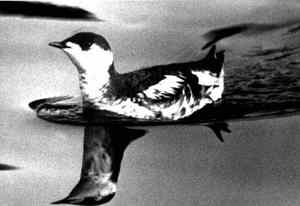From the Open-Publishing Calendar
From the Open-Publishing Newswire
Indybay Feature
Bad omen for endangered bird
Ravens, jays becoming murrelets' toughest foes

Eureka, CA - Ravens and jays are hammering the largest nesting population of endangered marbled murrelets in California, eating eggs and murrelet chicks needed to steady the birds' falling numbers, researchers say.
To counter the latest recognized threat to the small seabirds, the parks are revamping an educational program and taking a deeper look into how campgrounds contribute to the presence of the bigger birds.
”We're in a real tricky situation,” said park fish and wildlife biologist Keith Bensen. “We've got to do something.”
The birds in California already have a tenuous future. While there are nearly 1 million murrelets in Alaska, researchers expect the approximately 4,000 murrelets that forage offshore of the park to vanish in 50 to 100 years. Bensen said the jay and raven threat could make that timeline even shorter, since the number of young murrelets being produced are not making up for adult birds that die.
Using radio tracking, aircraft, video cameras and other techniques, researchers like Richard Golightly with Humboldt State University have found that a large number of the parks' nests are failing. Jays and ravens are playing a huge role.
While cutting of their old-growth habitat is responsible for the endangered status of murrelets today, Golightly said, parks long considered good refuges for murrelets are proving to be poorer habitat than once thought due to the heavy presence of jays and ravens.
”You need to take some action pretty quickly or you're not going to have a murrelet population any more,” Golightly said.
Bensen said that while jays and ravens are native to the area, fragmented forest lands they favor may have boosted their numbers significantly. Murrelets that could once find refuge in large areas of old growth that jays and ravens steered clear of, have only smaller patches of habitat available to them, he said. The largest stand of old growth in the parks is about 6,000 acres.
The availability of human food at campgrounds and picnic sites is also believed to be a magnet to ravens and jays.
So the parks are going on an educational campaign, incorporating warnings against feeding birds or not cleaning up after eating. Signs will be posted, and campfire programs and guided walks will all include mention of the problem. The park also hopes to have someone patrolling camping areas to talk with campers.
”If you're dealing with your food properly for bears, you're doing well for murrelets, too,” said park interpreter Jim Wheeler.
Education about bears has helped in areas plagued by the hungry, strong critters known to raid coolers and tents.
The parks will also be setting up monitoring efforts to see if their tactics force a change and help slow or reverse the decline of the local murrelets. Various techniques will be outlined in a Trail and Backcountry Management Plan expected out this fall.
To counter the latest recognized threat to the small seabirds, the parks are revamping an educational program and taking a deeper look into how campgrounds contribute to the presence of the bigger birds.
”We're in a real tricky situation,” said park fish and wildlife biologist Keith Bensen. “We've got to do something.”
The birds in California already have a tenuous future. While there are nearly 1 million murrelets in Alaska, researchers expect the approximately 4,000 murrelets that forage offshore of the park to vanish in 50 to 100 years. Bensen said the jay and raven threat could make that timeline even shorter, since the number of young murrelets being produced are not making up for adult birds that die.
Using radio tracking, aircraft, video cameras and other techniques, researchers like Richard Golightly with Humboldt State University have found that a large number of the parks' nests are failing. Jays and ravens are playing a huge role.
While cutting of their old-growth habitat is responsible for the endangered status of murrelets today, Golightly said, parks long considered good refuges for murrelets are proving to be poorer habitat than once thought due to the heavy presence of jays and ravens.
”You need to take some action pretty quickly or you're not going to have a murrelet population any more,” Golightly said.
Bensen said that while jays and ravens are native to the area, fragmented forest lands they favor may have boosted their numbers significantly. Murrelets that could once find refuge in large areas of old growth that jays and ravens steered clear of, have only smaller patches of habitat available to them, he said. The largest stand of old growth in the parks is about 6,000 acres.
The availability of human food at campgrounds and picnic sites is also believed to be a magnet to ravens and jays.
So the parks are going on an educational campaign, incorporating warnings against feeding birds or not cleaning up after eating. Signs will be posted, and campfire programs and guided walks will all include mention of the problem. The park also hopes to have someone patrolling camping areas to talk with campers.
”If you're dealing with your food properly for bears, you're doing well for murrelets, too,” said park interpreter Jim Wheeler.
Education about bears has helped in areas plagued by the hungry, strong critters known to raid coolers and tents.
The parks will also be setting up monitoring efforts to see if their tactics force a change and help slow or reverse the decline of the local murrelets. Various techniques will be outlined in a Trail and Backcountry Management Plan expected out this fall.
For more information:
http://www.times-standard.com/local/ci_393...
Add Your Comments
We are 100% volunteer and depend on your participation to sustain our efforts!
Get Involved
If you'd like to help with maintaining or developing the website, contact us.
Publish
Publish your stories and upcoming events on Indybay.
Topics
More
Search Indybay's Archives
Advanced Search
►
▼
IMC Network


